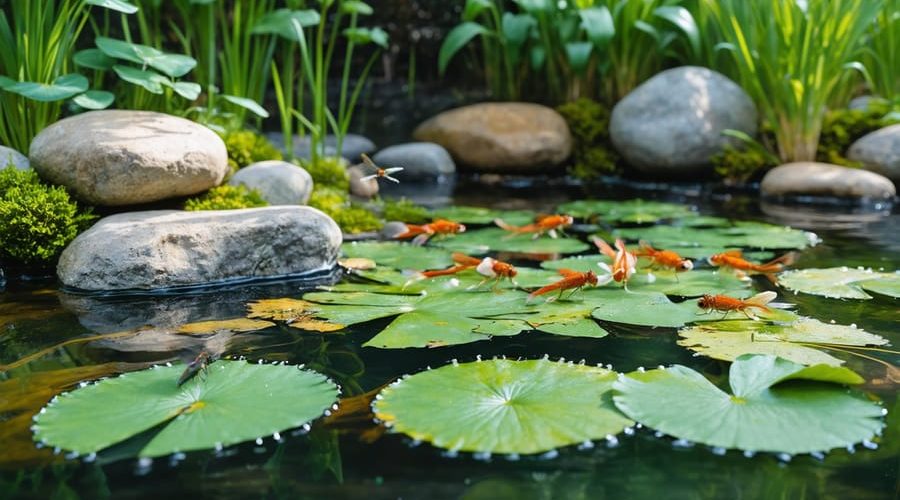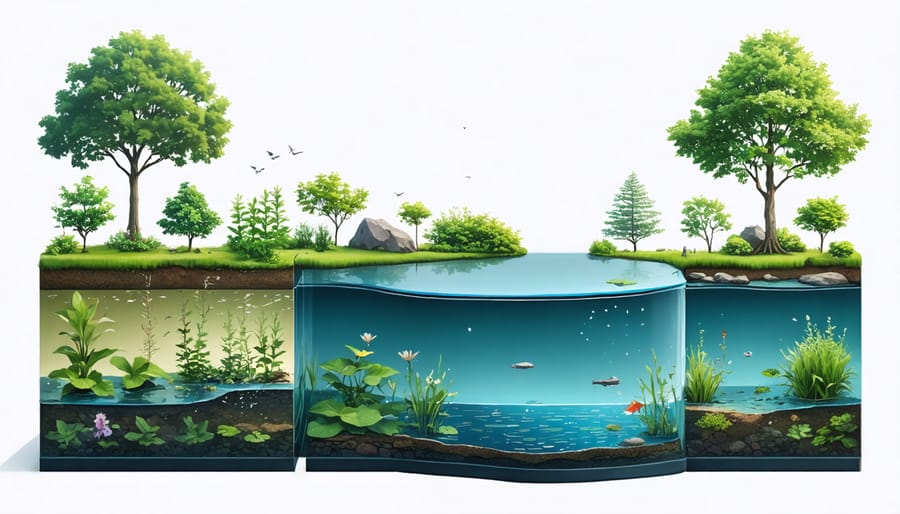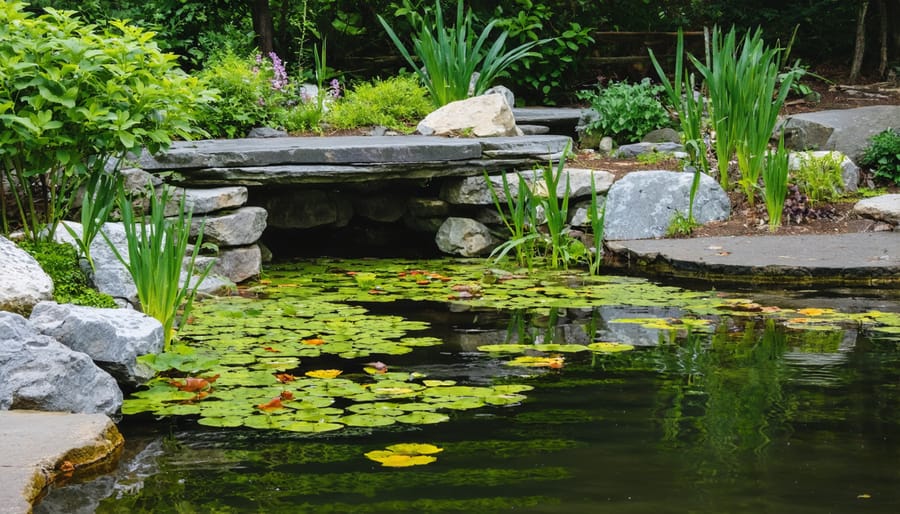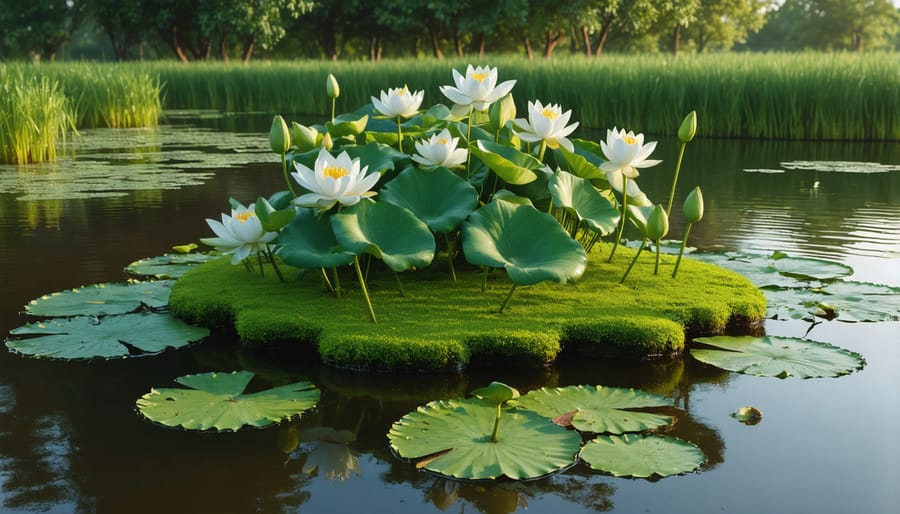
Transform Your Pond into a Living Paradise: Easy DIY Microhabitat Zones
Discover the hidden worlds within your backyard pond, where tiny ecosystems create thriving pond ecosystems teeming with life. From submerged rock gardens hosting darting minnows to floating plant islands sheltering tadpoles, microhabitats transform ordinary water features into vibrant nature sanctuaries. These miniature environments – some as small as a single lily pad – play crucial roles in supporting biodiversity, maintaining water quality, and creating self-sustaining aquatic communities. Whether you’re a seasoned pond keeper or just starting your water gardening journey, understanding these five distinct microhabitats will help you create the perfect balance of shelter, nutrition, and breeding spaces for pond wildlife. Let’s explore how simple additions like partially submerged logs, shallow gravel beds, and strategically placed aquatic plants can dramatically enhance your pond’s ecological value while creating stunning natural displays.

The Shallow Marginal Shelf
Plant Selection and Placement
For successful marginal zones, choose pond plants that boost biodiversity like marsh marigolds, iris, and rushes. Place taller species like cattails at the back, creating natural shelters for wildlife. Medium-height plants such as water forget-me-nots work beautifully in the middle zone, while creeping Jenny and water mint can spill over the edges.
Arrange plants in groups of three or five for a natural look, spacing them about 12 inches apart to allow for growth. Consider seasonal interest by mixing early-blooming iris with late-season cardinal flowers. For smaller ponds, stick to compact varieties like dwarf rushes and miniature water lilies.
Remember to plant marginals at the correct depth – generally, the crown should sit just at or slightly below water level. Use aquatic planting baskets filled with heavy clay-based soil to keep plants secure and prevent them from spreading too aggressively.
Wildlife Benefits
Creating diverse microhabitats in your pond attracts a wonderful variety of wildlife. Frogs and newts will quickly find shallow, planted areas, using them for breeding and shelter. Dragonflies and damselflies are drawn to emergent plants, where they lay eggs and perch while hunting. Birds love shallow beach areas for bathing and drinking, while beneficial insects like water beetles and water boatmen thrive in submerged plant zones.
To encourage more wildlife, maintain different water depths and include plenty of hiding spots using rocks and plants. Adding native species is particularly effective, as local wildlife naturally recognizes these as habitat. Leave some fallen leaves around the edges, as these provide shelter for beneficial insects and amphibians.
Remember that patience is key – once you’ve created suitable environments, wildlife will gradually discover your pond. Avoid using chemicals or pesticides, as these can harm the delicate balance of your pond’s ecosystem and its inhabitants.
Deep Water Sanctuary
Optimal Depth Guidelines
When planning your pond’s microhabitats, depth plays a crucial role in creating successful environments. For small garden ponds (4-6 feet wide), maintain shallow areas of 6-12 inches deep for marginal plants, with a deeper central zone of 18-24 inches for aquatic life. Medium-sized ponds (8-12 feet) benefit from varied depths, including 2-3 foot deep areas for fish and temperature stability.
In colder climates, include zones at least 3 feet deep to prevent freezing solid during winter. Warmer regions can work with shallower depths but should provide some areas of 24-30 inches to maintain cooler water temperatures during summer. Remember to create gradual slopes between different depth zones – this prevents erosion and allows wildlife to move safely between areas.
For container ponds or mini water features, even a 12-inch depth can support small microhabitats, though these will need more frequent maintenance and monitoring of water conditions.
Underwater Features
Creating underwater shelters is essential for a thriving pond ecosystem. Start by strategically placing large rocks of varying sizes along the bottom and sides of your pond. These create natural hiding spots and territorial markers for fish. Submerged logs or branches add a natural touch while providing excellent cover for smaller fish and aquatic creatures.
Don’t forget to incorporate underwater plants for different depths to create a layered habitat. Consider hardy species like anacharis or hornwort, which provide oxygen and shelter while helping maintain water quality. Position plants in clusters, leaving open swimming channels for fish to navigate freely.
For added diversity, create small caves using stacked rocks or purpose-built ceramic structures. These serve as spawning areas and refuge spots during temperature changes. Remember to secure all features firmly to prevent collapse, and avoid using materials that might alter your water chemistry.
Rock and Gravel Gardens
Rock and gravel gardens create essential spawning grounds and safe havens for pond inhabitants, mimicking natural stream beds and lake bottoms. By strategically placing different sizes of rocks and gravel, you’ll create multiple layers that serve various aquatic creatures.
Start with a foundation of larger rocks (4-8 inches) to form caves and crevices where fish can hide from predators and lay their eggs. Add medium-sized rocks (2-4 inches) around these structures to create transition zones and additional sheltered spots. Finally, scatter different grades of gravel, from pea-sized to slightly larger pieces, to complete your underwater landscape.
These rocky areas are particularly valuable for bottom-dwelling fish and invertebrates. Snails, freshwater shrimp, and aquatic insects will make their homes among the stones, helping to maintain your pond’s ecological balance. The spaces between rocks also trap organic matter, providing food for these small creatures.
For the best results, create multiple rock gardens at different depths. Shallow areas will warm up faster in spring, encouraging early spawning, while deeper zones offer year-round protection. Remember to place your rock gardens away from areas where falling leaves collect to prevent excess debris accumulation.
Consider adding water plants between the rocks to create an even more natural-looking environment. The combination of plants and rocks provides excellent coverage for small fish and helps maintain water quality.

Floating Plant Islands
Floating plant islands are a fantastic way to add vertical interest and create valuable microhabitats in your pond. These artificial islands, made from buoyant materials like foam or cork, provide a unique environment where plants can grow with their roots directly in the water. They’re particularly beneficial for wildlife, offering safe havens for small creatures and creating shaded areas beneath for fish.
To create your own floating island, start with a base of pond-safe foam or a commercial floating planter. Add a mixture of pond soil and aquatic planting media, then introduce a variety of plants. Consider including marginal plants like iris, rushes, or sedges, which naturally grow along water edges. These plants will establish strong root systems that hang down into the water, creating miniature underwater forests that shelter fish fry and aquatic insects.
Position your islands strategically around your pond, ensuring they have enough space to drift naturally with the wind. This movement helps oxygenate the water and prevents stagnant areas from forming. For added stability, you can anchor the islands with fishing line if needed, while still allowing slight movement.

Bog Filter Zone
A bog filter zone creates a fascinating microhabitat while serving as a natural filtration system for your pond. This shallow area, typically filled with gravel and aquatic plants, mimics natural wetlands and provides a home for beneficial bacteria that break down waste materials.
To create a bog filter zone, designate an area adjacent to your pond that’s roughly 20% of your pond’s surface area. Dig this section to a depth of 12-18 inches and line it with the same pond liner material. Fill the space with varying sizes of gravel, creating different layers that water can flow through. This creates countless tiny spaces where beneficial bacteria can colonize.
What makes this zone truly special is the variety of marginal plants you can incorporate. Plants like cattails, iris, and rushes thrive here, using nutrients from the water while their roots provide additional surface area for beneficial bacteria. These plants also create perfect hiding spots for small aquatic creatures and amphibians.
The bog zone acts like a living filter, processing nutrients that might otherwise feed unwanted algae. Water enters this area through a pump system, flows through the gravel and plant roots, and returns to the main pond clean and clear. Over time, you’ll notice frogs, dragonflies, and other wildlife making this microhabitat their home, adding both beauty and biodiversity to your water garden.
Creating microhabitats in your pond isn’t just about aesthetics – it’s about building thriving ecosystems that support local wildlife. Whether you choose shallow margins, deep zones, or floating gardens, each environment plays a vital role in pond health. Start small with one or two of these examples, and gradually expand as you gain confidence. Remember, even the smallest microhabitat can make a big difference in attracting and supporting diverse pond life. Happy pond gardening!
